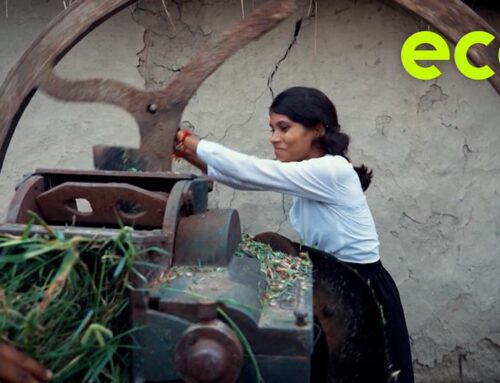‘Nature feeds us more than it floods us’: Asheville after-school program teaches kids to f
November 27, 2025
Juniper Stewart just turned 12. She wears a cropped orange sweater and her ginger curls in a bob. She used to like Taylor Swift, but now she’s more into the Cranberries and other indie rock.
Juniper also knows how to identify a Pilobolus mushroom, which grows on “cow poop”, according to Juniper. She can confidently harvest plantain leaf, a ubiquitous wild plant that’s tasty in salads and sautées, and useful as a poultice on stings and poison ivy. She has paper bags full of sourwood leaves drying at home to make tea, and she’s delighted by the fact that when you touch jewelweed seed pods, they explode.
Juniper’s deep knowledge of the wild plants around her home in western North Carolina stems from her involvement in an after-school program that taught kids in Asheville and surrounding towns how to forage. For three days a week this fall, foraging guides brought groups of students ages five to 12 from City Mountain Public Montessori out to forests and fields to learn about the plentiful berries, mushrooms, leafy greens and even flavorful sticks in their own backyard.
The program is the brainchild of Alan Muskat, a “philosoforager” who runs No Taste Like Home, an educational company that for the past 30 years has taught locals and tourists alike how to plumb the bounty of the southern Appalachians, one of the most biodiverse areas in the world. There are many different reasons to forage: self-reliance, connection with nature, sustainability, remembering where our food comes from.
But Muskat hatched his idea to teach kids in the aftermath of Hurricane Helene, the storm that devastated Asheville in September 2024, killing more than 100 and causing $59.6bn worth of damage. For Muskat, this program would serve as a “different kind of hurricane relief”.
Muskat has built his life philosophy on the idea that many of society’s ills stem from our fear of the natural world, our tendency to live in opposition to it rather than in harmony with it. After the hurricane, he wanted to impart those lessons on young people who lived through the storm.

“The intention was that by gathering food from nature, kids that just went through a hurricane that might have killed their friends might learn not to fear and distrust nature so much,” he said. “Nature feeds us more than it floods us.”
Helene still looms large in Asheville. Jessica Braun-Ferris, Juniper’s mom, wanted her daughter to connect with nature and to stoke enthusiasm about healthy plants rather than processed snacks. But Braun-Ferris was also thinking about last fall’s shuttered supermarkets and dirty water supply, the downed credit card machines that left the community scrambling for cash.
“It felt a little to me when the hurricane happened that we were in a dress rehearsal for what could happen with [future] natural disasters,” Braun-Ferris said. “The grocery store shelves were completely bare and people were eating government-rationed food, which is not as healthy as making a big chickweed [a common green in western North Carolina] salad.” She remembered a neighbor who’d built an elaborate filtration system and helped folks out when the water supply went down in the wake of the storm. What if foragers could play a similar role during the next disaster?
During the after-school program, a bus brought the kids from school to an educational site outside Asheville. Led by a No Taste Like Home guide, the kids would “run around and find things, and ask if they were edible”, according to Jemma Ferrington, nine, whose house was destroyed in the hurricane and who participated iparticipated in the program. She added: “I’d identify lots of things, like some mushrooms that had gills, and some that had a sponge at the bottom.” A baby chicken-of-the-woods mushroom was her favorite food she found, because it was “squishy and fun”.
The program has faced some setbacks. Muskat had trouble finding a bus driver, which delayed the program from spring 2025 to the fall. Then, a few disruptive students made the team reconsider whether it was wise to teach kids without parents present. “You don’t teach foraging to kids who aren’t paying attention,” Muskat said.
A staff member questioned Muskat after he let kids eat white milk cap mushrooms, which in large quantities can irritate the stomach, and pushed him to remind kids that not all white mushrooms are safe to eat (“he was right” about the second complaint, Muscat acknowledged in an email, adding that one of the “golden rules of foraging is, don’t overgeneralize”).
In addition to the after-school program, No Taste Like Home has run two foraging field trips, with plenty of chaperones to keep an eye on kids, which they hope to repeat in 2026.
No Taste Like Home has invited children who participated in its after-school program, which costs $4-$8 per session, to join the company’s regular foraging tours, with their parents, on weekends. On a chilly Saturday in late October, Braun-Ferris, Juniper, and Jemma joined guide Dimitri Magiasis on a tour. Magiasis, who discovered the world of foraging while studying to be a naturopath in Seattle, has worked for Muskat for nine years, leading a couple tours per week. He said he’s always delighted when kids join his weekend tours.
“Kids aren’t indoctrinated yet,” he said. “They’re taken by the plants and by the mushroom world in a way that I can’t put into words. Because of that, they can really get immersed in a deep way.”
Magiasis’s tour began in Black Mountain, about 15 miles outside Asheville, on the grounds of a community where residents live off the land. The road from the interstate was one-way and unpaved, still under construction from Helene. Magiasis gathered the group near a rushing brook to explain that they’d be “meeting” plants such as cool-weather greens, herbs and spices, and mushrooms, although this fall has brought a drought to the region that’s rendered the mushroom population sparse.
That’s just a part of foraging, said Magiasis. The practice forces you to redefine the way you think about food availability. “You go into the grocery store and find onions, apples, lettuce 365 days per year,” he said. “Nature doesn’t work that way. She’s going to provide what she’s going to provide.” He compared the emergence and decay of different plants throughout the year to an orchestra.

Two minutes from the parking lot, Magiasis stopped in a field and started scouting for leafy greens. Jemma and Juniper show off their knowledge: when Magiasis asks about a furry vine clinging to a tree, they shriek, “poison ivy!” They chomp on the sticks that Magiasis breaks off an unassuming tree in the field – spicebush, which is good for tea. As we progress into the woods, Magiasis leads us to leafy greens like chickweed, plantain, and wood sorrel; bright purple American beauty berries he uses for jams or sprinkling on desserts; and mushrooms like turkey tail and steak of the woods, which shares the same carmine color as its rare-cooked namesake. At the end of the tour, Magiasis sautées one of those steak-of-the-wood mushrooms with some greens and serves them on crackers, which, he jokes, he foraged from Trader Joe’s.
On the tour, Magiasis is strict about safety. When we’re looking for chickweed, he points out the plant’s chief identifying features: the leaf edges are smooth, not serrated. They’re shaped like spades, or hearts, and furry on only one side. He checks each person’s leaf before they’re allowed to eat it, then counts one, two, three before we pop them into our mouths.
For many, safety is a big question around foraging, especially for kids. Ten to 12 mushroom species in western North Carolina are deadly, for example, and a couple hundred more will make you extremely sick. But guides and parents alike stressed that knowledge is power and that for them, it’s actually more dangerous not to teach their kids how to forage.
“Kids who are not learning how to forage are always gathering things. It’s just what kids do,” said Braun-Ferris, reminiscing about how Juniper used to clamor to eat unidentified red berries in their yard when she was a toddler. “Learning this stuff is safer than not.”
For Muskat, Magiasis, and the other guides, potential safety concerns are far outweighed by the joy and power in watching kids realize where their food comes from. “I had a kid the other day who said, ‘It’s so amazing that you can turn nature into food,’” Muskat said.
Search
RECENT PRESS RELEASES
Related Post




